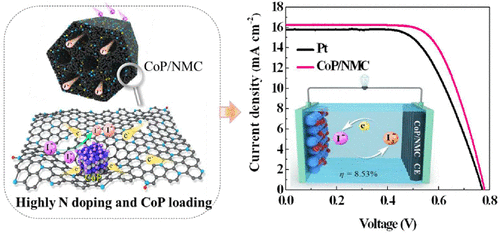当前位置:
X-MOL 学术
›
ACS Sustain. Chem. Eng.
›
论文详情
Our official English website, www.x-mol.net, welcomes your
feedback! (Note: you will need to create a separate account there.)
Molecular-Level Synthesis of Cobalt Phosphide Nanocrystals Confined in Highly Nitrogen-Doped Mesoporous Carbon Electrocatalyst for Highly Efficient Dye-Sensitized Solar Cells
ACS Sustainable Chemistry & Engineering ( IF 7.1 ) Pub Date : 2020-11-13 , DOI: 10.1021/acssuschemeng.0c06106 Ming Chen 1, 2 , Leng-Leng Shao 3 , Meng-Yang Dong 1 , Xian-Wei Lv 4 , Zhong-Yong Yuan 2, 4 , Xing Qian 5 , Yu-Yu Han 1 , Ai-Xiang Ding 1, 6
ACS Sustainable Chemistry & Engineering ( IF 7.1 ) Pub Date : 2020-11-13 , DOI: 10.1021/acssuschemeng.0c06106 Ming Chen 1, 2 , Leng-Leng Shao 3 , Meng-Yang Dong 1 , Xian-Wei Lv 4 , Zhong-Yong Yuan 2, 4 , Xing Qian 5 , Yu-Yu Han 1 , Ai-Xiang Ding 1, 6
Affiliation

|
Developing an efficient synthetic approach for the accurate synthesis of nonprecious metal counter electrode (CE) electrocatalysts with superior catalytic activity and electrochemical stability is critically important for the commercial application of dye-sensitized solar cells (DSSCs). In this study, a new molecular-level synthetic strategy was innovatively developed by copolymerization of melamine and resorcinol with formaldehyde under specific pH conditions and their hydrothermal cooperative assembly with organic–inorganic cobalt phosphate and F127 to construct the high-molecular-weight EDTMPA-Co/melamine-formaldehyde-resorcinol resin/F127 copolymer with good thermal stability and compositional homogeneity. The subsequent carbothermal reduction of EDTMPA-Co using melamine-formaldehyde-resorcinol resin as carbon–nitrogen cosources and F127 as a soft template contributed to the accurate synthesis of uniformly dispersed cobalt phosphide nanoparticles incorporated in a highly nitrogen-doped mesoporous carbon (CoP/NMC) catalyst for the first time. It was found that the abundant mesopores, high-nitrogen-content conductive carbon walls (12.8 atom %), and numerous exposed CoP nanoparticles were creatively formed in the resultant CoP/NMC hybrid, which greatly accelerated the electrolyte/electron transportation and supplied sufficient ion-accessible electrocatalytic nanoactive sites for catalysis. When applied as a CE catalyst, the CoP/NMC hybrid revealed a strong synergistic effect in adsorption and catalytic reduction of triiodide ions, and the CoP/NMC reached a low charge transfer resistance (Rct) of 1.35 Ω. As a consequence, the CoP/NMC CE assembled DSSC delivered a high photo-to-electricity conversion efficiency (η) of 8.53% and exceptional long-term electrochemical stability with a remnant efficiency of 7.80% after 200 h of illumination, outperforming the state-of-the-art Pt. The catalytic mechanism of CoP/NMC CE toward triiodide reduction was studied by density functional theory calculations, which revealed that the relative energy for breaking the I–I bond was significantly improved by chemisorption-induced formation of Co–I covalent bonds between the triiodide intermediate and Coσ+ atoms in the exposed CoP nanoactive sites, and the electrocatalytic reduction of I2* to I–* was substantially facilitated.
中文翻译:

高效染料敏化太阳能电池中高氮掺杂介孔碳电催化剂中受限的磷化钴纳米晶体的分子级合成
开发一种有效的合成方法以精确合成具有优异催化活性和电化学稳定性的非贵金属对电极(CE)电催化剂对于染料敏化太阳能电池(DSSC)的商业应用至关重要。在这项研究中,三聚氰胺和间苯二酚与甲醛在特定的pH条件下共聚,并与有机-无机磷酸钴和F127进行水热合作组装,从而构建了高分子量的EDTMPA-Co,从而创新性地开发了一种新的分子级合成策略。 /三聚氰胺-甲醛-间苯二酚树脂/ F127共聚物,具有良好的热稳定性和组成均匀性。EDTMPA-Co随后的碳热还原反应使用三聚氰胺-甲醛-间苯二酚树脂作为碳-氮共源,F127作为软模板,有助于准确合成均匀分散的磷化钴纳米颗粒,该纳米颗粒掺入高度氮掺杂的介孔碳(CoP / NMC )的催化剂。结果发现,在所得的CoP / NMC杂化物中创造性地形成了丰富的中孔,高氮含量的导电碳壁(12.8原子%)和大量暴露的CoP纳米粒子,这大大加快了电解质/电子的输送并提供了足够的离子-可接近的用于催化的电催化纳米活性位点。当用作CE催化剂时,CoP / NMC杂化物在三碘化物离子的吸附和催化还原方面显示出强大的协同作用,R ct)为1.35Ω。因此,CoP / NMC CE组装的DSSC可以提供8.53%的高光电转换效率(η),以及出色的长期电化学稳定性,在光照200小时后的剩余效率为7.80%,优于国家标准最先进的铂 通过密度泛函理论计算研究了CoP / NMC CE对三碘化物还原的催化机理,发现通过化学吸附诱导三碘化物中间体之间形成Co-I共价键,可以显着改善打破I–I键的相对能量。和暴露在CoP纳米活性位中的Coσ +原子,大大促进了I 2 *到I – *的电催化还原。
更新日期:2020-11-23
中文翻译:

高效染料敏化太阳能电池中高氮掺杂介孔碳电催化剂中受限的磷化钴纳米晶体的分子级合成
开发一种有效的合成方法以精确合成具有优异催化活性和电化学稳定性的非贵金属对电极(CE)电催化剂对于染料敏化太阳能电池(DSSC)的商业应用至关重要。在这项研究中,三聚氰胺和间苯二酚与甲醛在特定的pH条件下共聚,并与有机-无机磷酸钴和F127进行水热合作组装,从而构建了高分子量的EDTMPA-Co,从而创新性地开发了一种新的分子级合成策略。 /三聚氰胺-甲醛-间苯二酚树脂/ F127共聚物,具有良好的热稳定性和组成均匀性。EDTMPA-Co随后的碳热还原反应使用三聚氰胺-甲醛-间苯二酚树脂作为碳-氮共源,F127作为软模板,有助于准确合成均匀分散的磷化钴纳米颗粒,该纳米颗粒掺入高度氮掺杂的介孔碳(CoP / NMC )的催化剂。结果发现,在所得的CoP / NMC杂化物中创造性地形成了丰富的中孔,高氮含量的导电碳壁(12.8原子%)和大量暴露的CoP纳米粒子,这大大加快了电解质/电子的输送并提供了足够的离子-可接近的用于催化的电催化纳米活性位点。当用作CE催化剂时,CoP / NMC杂化物在三碘化物离子的吸附和催化还原方面显示出强大的协同作用,R ct)为1.35Ω。因此,CoP / NMC CE组装的DSSC可以提供8.53%的高光电转换效率(η),以及出色的长期电化学稳定性,在光照200小时后的剩余效率为7.80%,优于国家标准最先进的铂 通过密度泛函理论计算研究了CoP / NMC CE对三碘化物还原的催化机理,发现通过化学吸附诱导三碘化物中间体之间形成Co-I共价键,可以显着改善打破I–I键的相对能量。和暴露在CoP纳米活性位中的Coσ +原子,大大促进了I 2 *到I – *的电催化还原。











































 京公网安备 11010802027423号
京公网安备 11010802027423号